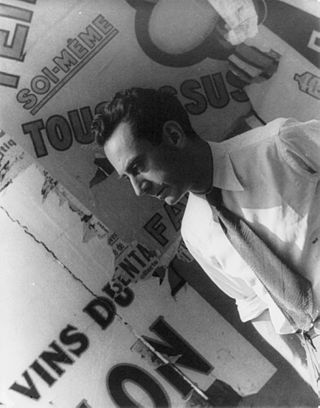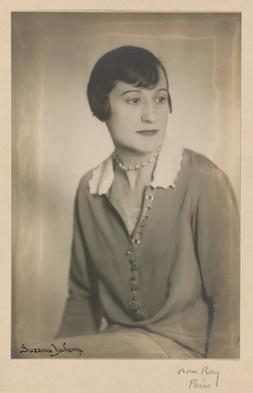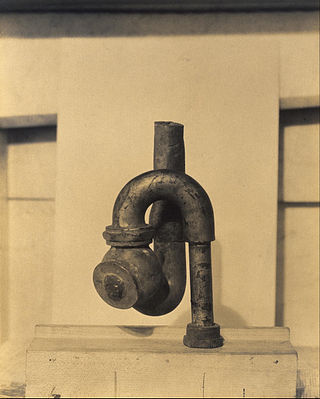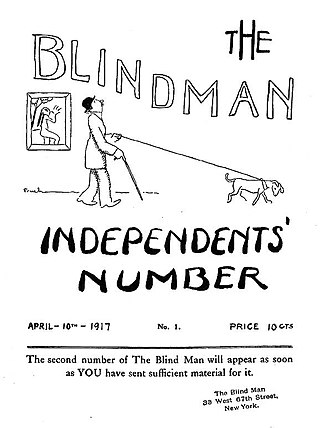Related Research Articles

Dada or Dadaism was an art movement of the European avant-garde in the early 20th century, with early centres in Zürich, Switzerland, at the Cabaret Voltaire, founded by Hugo Ball with his companion Emmy Hennings, and in Berlin in 1917. New York Dada began c. 1915, and after 1920 Dada flourished in Paris. Dadaist activities lasted until the mid 1920s.

Henri-Robert-Marcel Duchamp was a French painter, sculptor, chess player, and writer whose work is associated with Cubism, Dada, and conceptual art. He is commonly regarded, along with Pablo Picasso and Henri Matisse, as one of the three artists who helped to define the revolutionary developments in the plastic arts in the opening decades of the 20th century, responsible for significant developments in painting and sculpture. He has had an immense impact on 20th- and 21st-century art, and a seminal influence on the development of conceptual art. By the time of World War I, he had rejected the work of many of his fellow artists as "retinal", intended only to please the eye. Instead, he wanted to use art to serve the mind.

Man Ray was an American visual artist who spent most of his career in Paris. He was a significant contributor to the Dada and Surrealist movements, although his ties to each were informal. He produced major works in a variety of media but considered himself a painter above all. He was best known for his pioneering photography, and was a renowned fashion and portrait photographer. He is also noted for his work with photograms, which he called "rayographs" in reference to himself.

A found object, or found art, is art created from undisguised, but often modified, items or products that are not normally considered materials from which art is made, often because they already have a non-art function. Pablo Picasso first publicly utilized the idea when he pasted a printed image of chair caning onto his painting titled Still Life with Chair Caning (1912). Marcel Duchamp is thought to have perfected the concept several years later when he made a series of ready-mades, consisting of completely unaltered everyday objects selected by Duchamp and designated as art. The most famous example is Fountain (1917), a standard urinal purchased from a hardware store and displayed on a pedestal, resting on its back. In its strictest sense the term "ready-made" is applied exclusively to works produced by Marcel Duchamp, who borrowed the term from the clothing industry while living in New York, and especially to works dating from 1913 to 1921.

Beatrice Wood was an American artist and studio potter involved in the Avant Garde movement in the United States; she founded and edited The Blind Man and Rongwrong magazines in New York City with French artist Marcel Duchamp and writer Henri-Pierre Roché in 1917. She had earlier studied art and theater in Paris, and was working in New York as an actress. She later worked at sculpture and pottery. Wood was characterized as the "Mama of Dada".

Suzanne Duchamp-Crotti was a French Dadaist painter, collagist, sculptor, and draughtsman. Her work was significant to the development of Paris Dada and modernism and her drawings and collages explore fascinating gender dynamics. Due to the fact that she was a woman in the male prominent Dada movement, she was rarely considered an artist in her own right. She constantly lived in the shadows of her famous older brothers, who were also artists, or she was referred to as "the wife of." Her work in painting turns out to be significantly influential to the landscape of Dada in Paris and to the interests of women in Dada. She took a large role as an avant-garde artist, working through a career that spanned five decades, during a turbulent time of great societal change. She used her work to express certain subject matter such as personal concerns about modern society, her role as a modern woman artist, and the effects of the First World War. Her work often weaves painting, collage, and language together in complex ways.

Henri-Pierre Roché was a French author who was involved with the artistic avant-garde in Paris and the Dada movement.
Walter Conrad Arensberg was an American art collector, critic and poet. His father was part owner and president of a crucible steel company. He majored in English and philosophy at Harvard University. With his wife Louise, he collected art and supported artistic endeavors.

Fountain is a readymade sculpture by Marcel Duchamp in 1917, consisting of a porcelain urinal signed "R. Mutt". In April 1917, an ordinary piece of plumbing chosen by Duchamp was submitted for an exhibition of the Society of Independent Artists, the inaugural exhibition by the Society to be staged at the Grand Central Palace in New York. When explaining the purpose of his readymade sculpture, Duchamp stated they are "everyday objects raised to the dignity of a work of art by the artist's act of choice." In Duchamp's presentation, the urinal's orientation was altered from its usual positioning. Fountain was not rejected by the committee, since Society rules stated that all works would be accepted from artists who paid the fee, but the work was never placed in the show area. Following that removal, Fountain was photographed at Alfred Stieglitz's studio, and the photo published in the Dada journal The Blind Man. The original has been lost.

Elsa Baroness von Freytag-Loringhoven was a German-born avant-garde visual artist and poet, who was active in Greenwich Village, New York, from 1913 to 1923, where her radical self-displays came to embody a living Dada. She was considered one of the most controversial and radical women artists of the era.

Beatrice Wood: Mama of Dada is a 1993 documentary film written and directed by Tom Neff about the avant-garde Dada artist Beatrice Wood.

God is a circa 1917 sculpture by New York Dadaists Morton Livingston Schamberg and Elsa von Freytag-Loringhoven. It is an example of readymade art, a term coined by Marcel Duchamp in 1915 to describe his found objects. God is a 10½ inch high cast iron plumbing trap turned upside down and mounted on a wooden mitre box. The work is now in the Arensberg Collection in the Philadelphia Museum of Art.

Arturo Umberto Samuele Schwarz was an Italian scholar, art historian, poet, writer, lecturer, art consultant and curator of international art exhibitions. He lived in Milan, where he amassed a large collection of Dada and Surrealist art, including many works by personal friends such as Marcel Duchamp, André Breton, Man Ray, and Jean Arp.
Brice Brown is an American artist who lives and works in New York City.

The Blind Man was an art and Dada journal published briefly by the New York Dadaists in 1917.

New York Dada was a regionalized extension of Dada, an artistic and cultural movement between the years 1913 and 1923. Usually considered to have been instigated by Marcel Duchamp's Fountain exhibited at the first exhibition of the Society of Independent Artists in 1917, and becoming a movement at the Cabaret Voltaire in February, 1916, in Zürich, the Dadaism as a loose network of artists spread across Europe and other countries, with New York becoming the primary center of Dada in the United States. The very word Dada is notoriously difficult to define and its origins are disputed, particularly amongst the Dadaists themselves.

Tulip Hysteria Co-ordinating is a fictitious work of art by Marcel Duchamp.

Rongwrong was a New York Dadaist magazine of which one issue was published in May 1917. The magazine was co-created and edited by Marcel Duchamp, Henri-Pierre Roché, and Beatrice Wood.

Belle Haleine, Eau de Voilette is a work of art by Marcel Duchamp, with the assistance of Man Ray. First conceived in 1920, created spring of 1921, Belle Haleine is one of the Readymades of Marcel Duchamp, or more specifically a rectified ready-made.
References
- ↑ Richetti, Arianna (2022-09-16). "Duchamp: The Art of the Possible - Interview with Francis M. Naumann". DailyArt Magazine. Retrieved 2024-03-11.
- ↑ "Conversion to Modernism: The Early Work of Man Ray ; essays by Francis M. Naumann and Gail Stavitsky". tfaoi.org. Retrieved 2024-03-11.
- ↑ Greenberger, Alex (2019-10-07). "Dada Expert Francis Naumann Will Close Gallery, Citing Financial Pressures, Market Changes". ARTnews.com. Retrieved 2024-03-11.
- ↑ Naumann, Francis M. (2020). Naomi Savage: Stretching the Limits of Photography. Milton Art Bank. ISBN 978-1-7331840-3-8 . Retrieved 2024-03-11.
- ↑ Naumann, Francis M. (2018). Mentors: the making of an art historian. Los Angeles: DoppelHouse Press. ISBN 9780999754467.
- ↑ Shane, Robert R. (5 February 2020). "Francis M. Naumann's Mentors: The Making of an Art Historian". The Brooklyn Rail. Retrieved 11 March 2024.
- ↑ "Duchamp Scholar Francis Naumann Says He's Closing His New York Gallery Because Young People Find Modernism 'Passé'". Artnet News. 18 October 2019. Retrieved 11 March 2024.